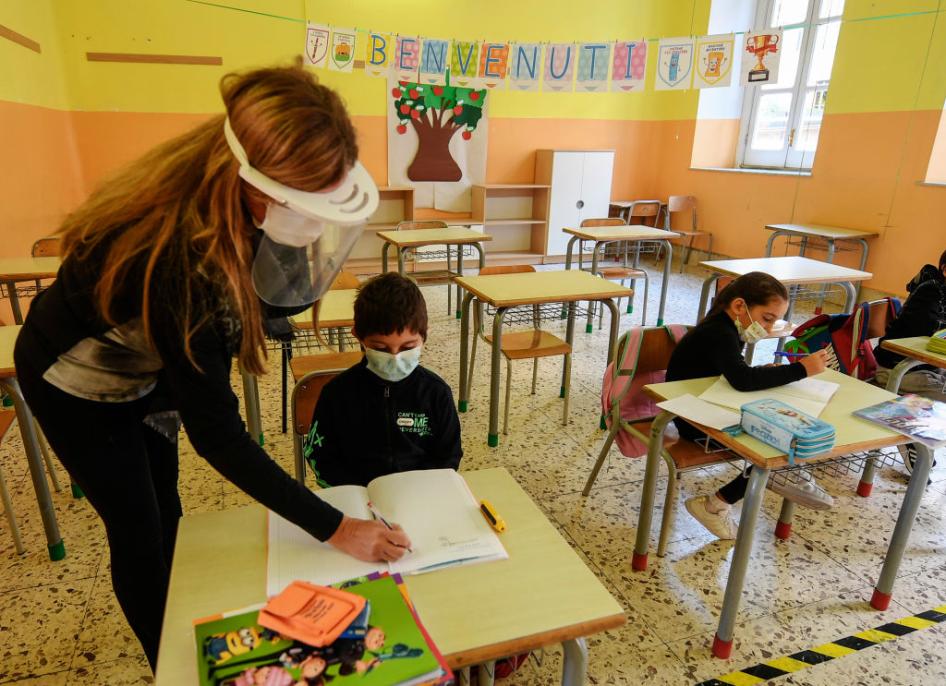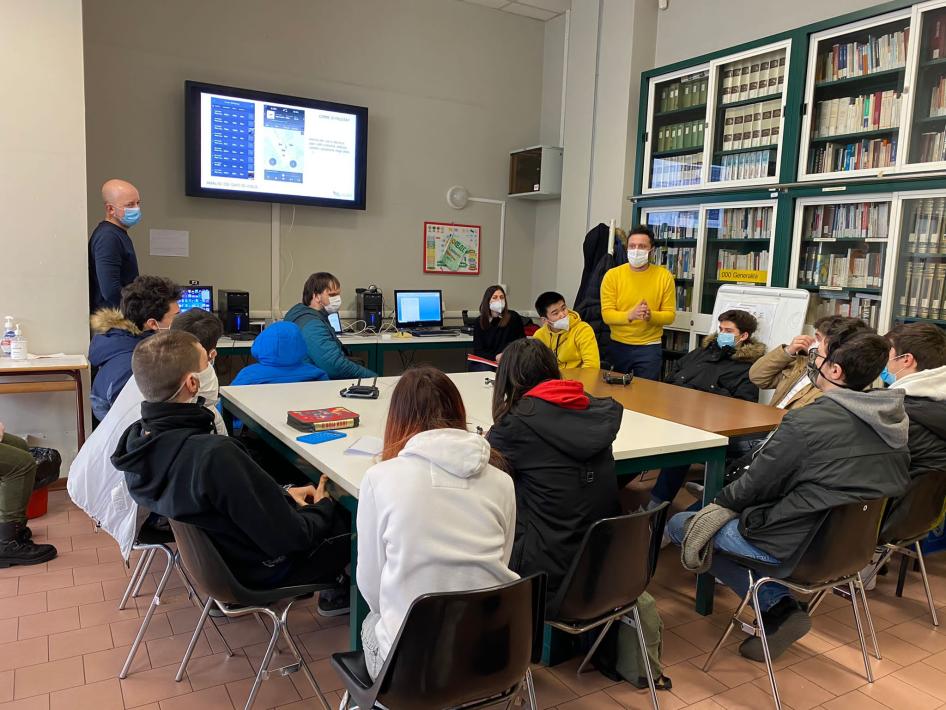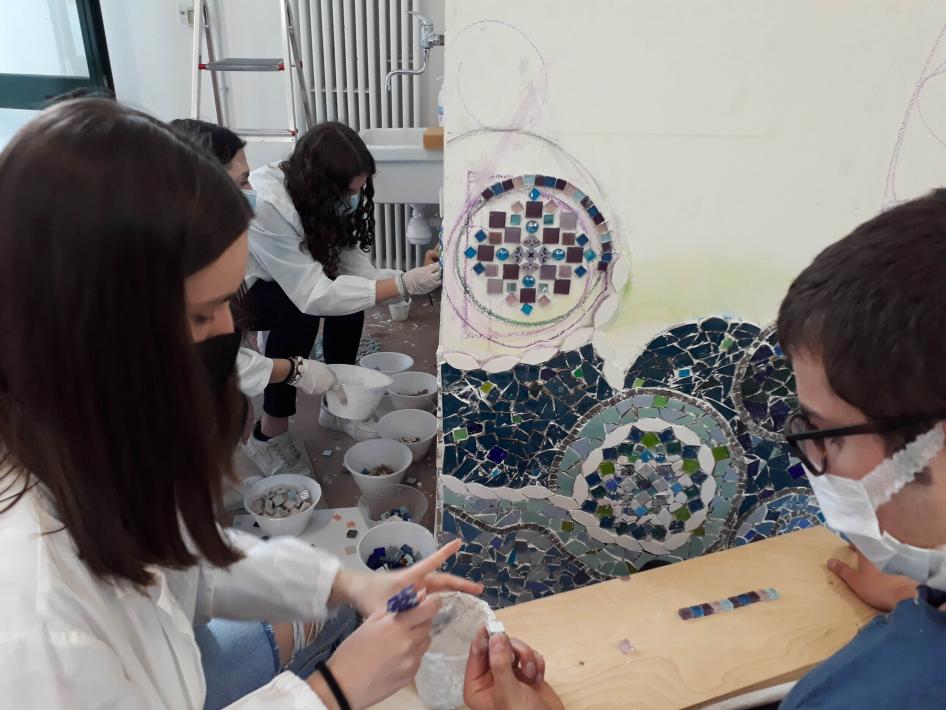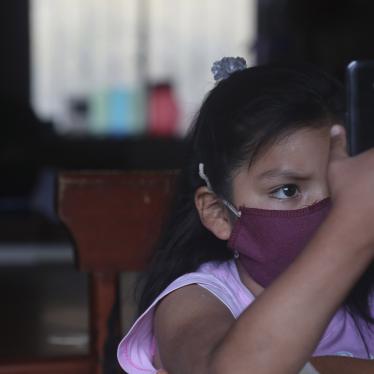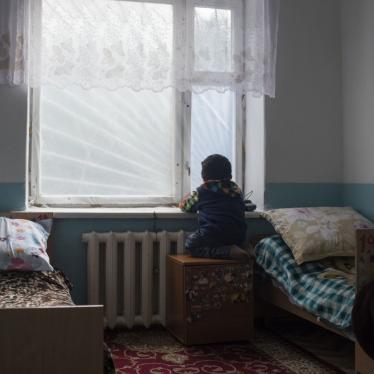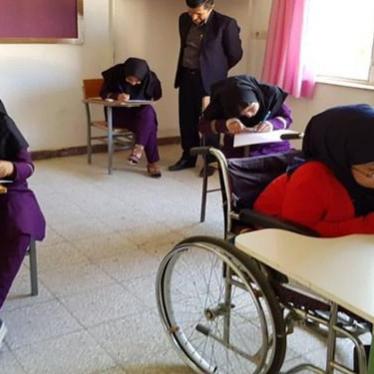(Bolzano) – The measures some schools in Italy took to ensure access to quality education for students with disabilities during Covid-19-related school closures should inspire other schools to follow suit, Human Rights Watch said today. The steps provided safe opportunities where possible for in-person learning during the pandemic.
Online remote learning due to pandemic-related school closures was difficult for many children. But it has been especially challenging for many children with disabilities who may particularly benefit from in-person education and the routine of going to school. In addition, online remote learning was often inaccessible for children with disabilities in Italy, as in other countries, risking their exclusion from education altogether.
“When remote learning proved inaccessible to many students with disabilities, some schools in Italy were able to take steps so students could study safely in classrooms, with the support they needed,” said Karolina Kozik, disability rights officer at Human Rights Watch. “The measures these schools took show that there are ways to provide students with disabilities access to quality, inclusive education, even in an emergency.”
Human Rights Watch interviewed families and staff regarding practices at 14 schools in Italy with a variety of approaches to education for children with disabilities during the pandemic and looked in greater depth at two schools. Human Rights Watch did not analyze the overall response of the Italian education system to the education of children with disabilities during the Covid-19 pandemic, which was beyond the scope of this research.
This research focused specifically on identifying schools that were able to provide in-person education programs for students with disabilities when available online education was inadequate to meet the students’ needs. It highlights positive examples that countries may consider to ensure access to quality education for students with disabilities when schools are closed for public health emergencies.
Parents said that despite schools’ efforts and the availability of devices and internet connection, remote learning often did not meet the educational needs of their children, who required in-person support. One mother, whose 13-year-old son has autism and is nonverbal, said: “Some children with disabilities can access remote learning with ease, but for him it’s impossible. It’s impossible to attract his attention through a screen for more than four minutes.”
Several government decrees beginning in November 2020 relating to the pandemic included provisions allowing for in-person activities for students with disabilities when schools were otherwise closed. In March 2021 an Education Ministry note clarified that in-person education for students with disabilities was not automatic, but rather that schools should consider each individual case to meet the student’s educational needs while respecting safety measures to protect the right to health.
The option for in-person learning was offered as an essential reasonable accommodation for students with disabilities who could not benefit from remote learning, particularly students with intellectual and complex disabilities who receive support from support teachers and professional aides at school.
Following the shift to remote learning in November, officials at the Gaetano Salvemini public technical high school in Casalecchio di Reno, in the northern region of
Emilia-Romagna, took the initiative to create small groups of about five students with and without disabilities who could choose to attend school in person when schools were otherwise closed. School officials chose students without disabilities to participate based on expressed interest and their specific challenges to participating in online learning. Each small group studied with teachers in the classroom, while other classmates joined the class online through interactive technology.
Students with and without disabilities who were part of inclusive groups appreciated the chance to attend school in person. “One of my friends told me it was a positive thing, also for [our classmate with disability], and so I decided to come,” said Giacomo, an 18-year-old student at the Salvemini high school. “The pandemic left a mark on us … and so I thought that perhaps in this dark time I could support [my classmate] … and now I'm also happier.”
Some schools instead offered students with disabilities the option to study individually in schools with support teachers and professional aides or to participate in workshops with other students with disabilities. Workshops included activities such as music, dance, and art. In some cases, classmates at home joined the children in the classroom via video calls.
Parents whose children attended school in person said that it was essential for their quality education. One mother of a 14-year-old boy with an intellectual disability and epilepsy said that the option for him to attend school was “like manna from heaven,” particularly given that schools were among the only institutions that continued to operate, while other support services and activities were suspended.
In both models, students with disabilities were given the choice of in-person learning or to continue remotely, as most students did. Students and parents stressed the importance of having this choice.
Human Rights Watch could not confirm how many schools in Italy offered in-person education for children with disabilities due to the lack of available data. Organizations representing people with disabilities and their family members have criticized the overall record of schools across Italy during the pandemic, noting that many children with disabilities did not receive a quality, inclusive education or, in some cases, any education at all.
According to the Italian National Institute of Statistics, 23 percent of students with disabilities did not participate in remote education between April and June 2020. Teachers Human Rights Watch interviewed said that students with disabilities were among those who were most likely to have fallen behind in their education during the pandemic.
Some schools were able to provide in-person classes only for children with disabilities, which some organizations, parents, and school officials criticized, expressing fears about the risk of setting precedents of separate classes for students with disabilities.
Italian law includes the right for all children to learn in inclusive settings in community schools, with reasonable accommodations. International treaties ratified by Italy guarantee the right to quality, inclusive education for children without discrimination. This entails ensuring that children with and without disabilities learn together in mainstream classes in an inclusive environment, with reasonable accommodations and accessibility to support quality education.
The public health measures put in place around the globe to address the spread of the coronavirus interfered with children’s right to an education as envisaged under human rights law, Human Rights Watch said. Governments should ensure that this interference is at the most minimal level practicable, and only to the extent that it is necessary, proportionate, and for the shortest possible time.
Governments should keep in-person school closures to a minimum based on objective, evidence-driven indicators of when in-person school closures might be justified by the risk of coronavirus transmission, taking into consideration all available measures short of closure to mitigate that risk. Governments should ensure that distance learning alternatives are accessible for children with disabilities and provide reasonable accommodations to meet the individual learning needs of each child with a disability.
“Some schools in Italy have demonstrated ways to provide students with disabilities with accessible quality education, even in an unprecedented crisis like the Covid-19 pandemic,” Kozik said. “Other schools in Italy and beyond can use these examples to make sure education is accessible to all children with disabilities at all times.”
For additional details about the issues involved and the models used by some school districts for in-person learning, please see below.
By early March 2020 schools and universities in Italy closed nationwide with a shift to remote learning, which lasted until the end of the school year in June. Groups representing people with disabilities and their families urged the government to allow in-person learning for children with disabilities as a reasonable accommodation in the event of school closures during the September 2020 – June 2021 school year. In its June 2020 plan for the coming school year the Education Ministry said schools should prioritize in-person schooling for students with disabilities.
When schools reopened in September, students did attend in person. However, while there were no nationwide school closures during the school year, national and regional authorities determined when there was a need for localized closures based on the course of the pandemic, with some schools remaining fully or partially closed for extended periods, most often upper secondary schools.
Starting in November, national government decrees included provisions allowing for in-person education for children with disabilities. Some regions issued separate provisions. The Education Ministry issued clarifying guidelines in November and March, saying that schools offering in-person activities should, when possible, involve students without disabilities to promote inclusion.
Schools that offered in-person learning to children with disabilities took various approaches. Some, particularly those with more experience in inclusive education, organized small inclusive groups, in some cases in response to pressure from parents of children with and without disabilities. Others provided one-on-one instruction with support teachers or professional aides, and in some cases students with disabilities at school connected to online classes with the students learning at home.
A Look at Innovative Programs
Between January and May, Human Rights Watch interviewed 52 people, including 11 children and young adults ages 14 to 19, 7 of them with disabilities, and family members of children with disabilities, school principals, support teachers, and professional classroom aides who support children with disabilities at 14 schools in the Emilia-Romagna, Lazio, Lombardy, and Piedmont regions, and in the autonomous province of Bolzano.
Human Rights Watch also interviewed members of organizations representing people with disabilities and their families, and an inclusive education expert. The names of some interviewees have been withheld at their request.
The 14 schools had a variety of approaches to education for students with disabilities during the pandemic. Human Rights Watch looked in greater depth at the Gaetano Salvemini public technical high school in Casalecchio di Reno, near Bologna, which offered in-person inclusive education, and the Giovanni Pascoli public high school (liceo) in Bolzano, which offered in-person education to children with disabilities only. The schools were chosen as examples of different ways in which schools organized in-person learning for high school students with disabilities.
The schools Human Rights Watch identified were required to follow public health safety measures to prevent the spread of the virus that causes Covid-19. Students and staff members wore face masks and other personal protective equipment, including disposable gloves and gowns, and maintained a two-meter distance, with limited exceptions.
When distancing was not possible, such as when professional aides provided one-on-one support to students, aides used other personal protective equipment including plastic face shields, and disposable gloves and gowns. Some schools used plexiglass dividers for desks. Schools kept registers and contact information for everyone entering and leaving the building.
In-Person Inclusive High School Education
In November the Gaetano Salvemini technical high school asked families of the school’s 1,400 students to indicate their interest in attending school in person. Students could also choose to join classes from home via video. School officials formed small groups of five to six students both with and without disabilities. The number of students attending in person varied during the lockdowns between November and April, from fewer than 100 to about 240, depending on students’ interest and families’ concerns about the risk of Covid-19 infection. The school had 74 children with disabilities enrolled in the 2020-2021 school year.
The school also offered inclusive workshops, including in music, arts, sports, and learning to use drones. One workshop was designed to foster students’ autonomy with instruction in managing personal finances.
Students with disabilities who attended school in person said it was a positive experience. “I went with two of my classmates and it went well, we did the usual things,” said Matteo, a 16-year-old third-year student with intellectual and physical disabilities. “I was happy to go to school, though I missed the others [students] a bit.”
Students without disabilities also said they had positive experiences. “I decided to go to school in person to help [my classmate with disability] because he is better when he’s with us,” said Mattia, a 17-year-old student who attended the Salvemini school in person as part of an inclusive group. “I also wanted to escape the routine of remote learning, where you had to wake up and participate in classes until 2 p.m. and stay at home. It was stressful and I couldn't stay focused, and when I started coming to school, my concentration and my grades improved.”
Some students without disabilities noted they had more opportunities to interact with a classmate with a disability while working in a small group, and they got to know each other better. Maria Ghiddi, the school’s vice principal, said that the school’s approach is to empower students with and without disabilities on an equal basis. “We saw that [inclusive education is] an important resource for non-disabled students, too,” Ghiddi said, adding that it was important to ensure that students played a leading role in projects proposed by the school.
One mother of a fifth-year high school student with physical and intellectual disabilities said her son initially was reluctant to go to school, as he did not want to feel different from his peers who were learning remotely. She said the school listened to her son’s request and allowed him to attend two to three days a week. The other days he joined classes online with his class and worked with his support teacher. “Then, after a while, he decided to increase [the number of days at school], and then he went every day,” she said. “Sometimes there were two or three classmates [without disabilities] with him, on other days he was alone. But in the end, he was happy to go.”
The Salvemini school in Casalecchio di Reno has a long history of inclusive education. Carlo Braga, the school’s principal, said that they had made important investments in equipment in the years before the pandemic. After the schools closed in March 2020, the school bought additional devices for students, as well as microphones and video equipment for classrooms. “These are structural investments for the school, not emergency ones,” he said. “These are things that will remain.”
Despite the school's experience in inclusive education, officials acknowledged the challenges with sustaining inclusive education during lockdowns. “We were already rather strong on inclusion, but I must say it was very difficult to organize,” said Ghiddi, the vice principal, adding that the main difficulties were concerns about health risks and a lack of interest in attending among some students with and without disabilities.
Other In-Person Practices During Pandemic-Related School Closures
Other schools adopted different models of inclusion. For example, the elementary and middle school complex [in Italian, istituto comprensivo] Via Nitti in Rome, which has 1,180 students, including 43 with disabilities, was closed for two weeks in March 2021 because of the course of the pandemic. School officials organized in-person non-academic workshops for students with and without disabilities, even as all academic classes were held online.
“Inclusion of children with disabilities has been a fundamental element of our school complex since its creation in the school year 2012-2013,” said the principal, Elisamarzia Vitaliano. At the start of the March lockdown, school officials wrote to parents to explain what the school would offer in terms of in-person activities. “We said that we would organize workshops [for students with disabilities] and that it would be good if other students participated,” Vitaliano said.
Those who opted in participated in workshops three and a half hours a day on topics including gardening, music, and art, some of which were co-organized by local organizations. The workshops were held only for the middle school, as families of children in the elementary school did not express interest in participating.
“Francesco went to the school every day, it was really important that they guaranteed a routine,” said Federica Morelli, mother of a 13-year-old boy with autism, adding that every day her son was accompanied by two or three classmates without disabilities, rotating on different days of the week. She added that interacting in a small group offered an opportunity for some of the children to get to know her son better, “in a calmer context, without distractions.”
At another elementary school in Rome, students with disabilities attended in person every day for three hours, with some classmates without disabilities attending two days a week. Regular teachers taught from school and children in those classrooms connected to online classes with the rest of their classmates.
In-Person Education Only for Students with Disabilities
Other schools, including the Giovanni Pascoli high school in Bolzano, in northern Italy, offered in-person education only for students with disabilities. When high schools in Italy closed in November, professional classroom aides (collaboratori all’integrazione) from the Pascoli high school reached out to individual students with disabilities and their families to discuss options for organizing their education. Decrees issued by local authorities in Bolzano province allowed for in-person learning for students with disabilities but did not reference inclusion of peers without disabilities.
Students with disabilities who attended in person at times connected to online classes from the classroom to participate in the regular classroom teaching, which was only online. Otherwise, they worked with support teachers and professional aides individually or participated in workshops with other students, including circus arts, dance, and music therapy.
Pascoli high school students Human Rights Watch interviewed said they were glad to come to school. “It’s better at school,” said Edoardo, a 19-year-old student with an intellectual disability in his final year of high school. “I didn’t like to stay at home all the time.”
Parents of children with disabilities enrolled in the school felt that the opportunity for in-person learning, even though it was not fully inclusive, was essential for their children to continue their education effectively. “It’s sad because they’re not with their classmates … but it’s better than nothing,” said Monica Bonomini, mother of a 19-year-old with an intellectual disability. “It would have been worse without this. I saw he was getting worse when he was at home all the time. They’re a nice group, they have fun.”
Sabine Bertagnolli, whose son Matteo, 14, is in his first year at the Pascoli high school, said that “some families [worried] that we were returning to separate classes, that students with disabilities would be segregated again. But I am … grateful, and inclusion can be achieved in other ways.”
Parents of children with disabilities in schools that offered in-person education only for them during pandemic-related school closures noted that since remote, online education did not meet the needs of their children, they felt the option of in-person education, even while not inclusive as usual, was essential for their children’s continued education. Not all students with disabilities had to attend in person, even if they have a support teacher and a professional aide supporting them at school. They could choose to attend in person or continue remote learning.
One mother whose 16-year-old daughter has an intellectual and physical disability and for whom online learning was not adequate, said: “It’s good that they can go to school, they need company, they need to stay together.” She added that her daughter, who is in her third year of middle school in Bolzano, “[could] not follow classes on a tablet. She doesn’t speak, only single words. She watches a bit, but she’s not interested in video calls.”
Another mother, whose 12-year-old son has autism and is nonverbal, said that despite efforts by the school and family, remote learning was not working for him. “The entire social aspect was gone, he disappeared [for the other students] because he couldn’t participate.”
Choice for In-Person or Remote Learning
Schools examined by Human Rights Watch that provided in-person education to students with disabilities allowed them to choose to attend or to study remotely. Having the opportunity to choose was important for many students and parents. At the Pascoli high school and at other schools, some students with disabilities, often those for whom online learning was accessible, preferred not to attend school in person and chose remote learning. They had individual calls with support teachers, who assisted them with overall comprehension, homework, and organizational skills.
One 18-year-old student with autism said he chose not to participate in in-person education and felt that distance learning had some advantages, even though he missed his classmates.
School staff from several other schools said that some children with disabilities opted to study remotely. For example, a support teacher in a high school in Milan said that only 15 out of 85 students with disabilities in the school decided to attend every day, as others felt that distance learning was working for them.
One mother of an 8-year-old boy with autism who attends a primary school in Rome said she chose not to send him to school because online learning was accessible to him and because it was not clear if any non-disabled peers would be at school.
